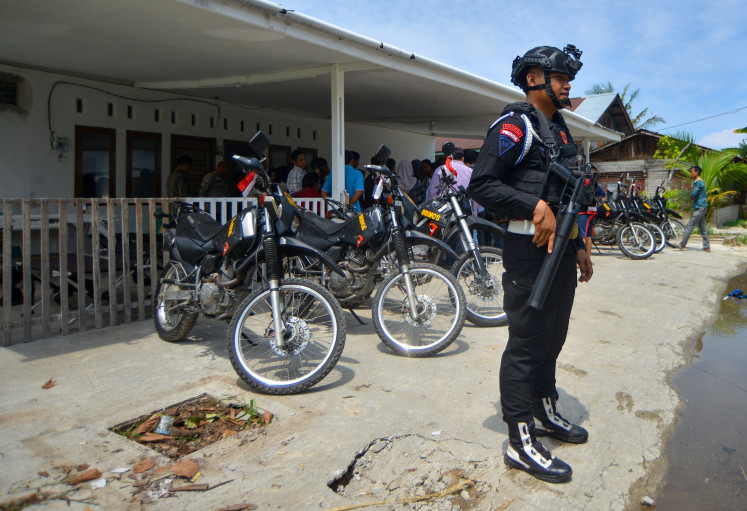Popular Reads
Top Results
Can't find what you're looking for?
View all search resultsPopular Reads
Top Results
Can't find what you're looking for?
View all search resultsIndonesia sees lower fertility rate
Indonesia’s total fertility rate (TFR) has decreased as a result of improved knowledge and awareness of contraception, leading to increased contraceptive use, a new survey revealed on Monday
Change text size
Gift Premium Articles
to Anyone
I
ndonesia’s total fertility rate (TFR) has decreased as a result of improved knowledge and awareness of contraception, leading to increased contraceptive use, a new survey revealed on Monday.
Commissioned by the National Population and Family Planning Agency (BKKBN), the 2017 Indonesian Demographic and Health Survey (SDKI) further reveals that unmet family planning needs in the country also declined.
“In our efforts to achieve the desired [total fertility] rate, the BKKBN has striven to improve access to and the quality of health and contraceptive care services in areas across the country,” said the agency’s family planning and reproductive health division deputy head, Dwi Listyawardani.
After remaining stubbornly high at 2.6 from 2002 to 2012, Indonesia’s TFR dropped to 2.4 in 2017, according to the new SDKI report.
TFR can be defined as the average number of children born to a woman who survives the reproductive years of between 15-49.
Despite such an improvement, there is still much to do, as BKKBN has set a TFR target of 2.3 by 2019. The agency has also set a target to lower the rate to 2.1 by 2025 in its efforts to meet the goal of decreasing Indonesia’s population growth rate to 1.19 percent between 2015 and 2020 from the previous rate of 1.38 percent during the 2010-2015 period and 1.49 percent from 2000 to 2010.
Conducted by interviewing 47,936 eligible households in areas across Indonesia, the 2017 SDKI reveals that East Java has the lowest TFR, which stands at 2.1, while East Nusa Tenggara (NTT) has the highest rate, at 3.4.
NTT, one of the three provinces with the highest TFR, along with Maluku and Papua, which are all located in the eastern part of Indonesia, was known to have limited access to contraceptive services, said Dwi.
“Java, Sumatra and Kalimantan have good services, but in regions across eastern Indonesia, we are still struggling with access,” she said.
With improved access to and quality of health and contraceptive care services, the unmet need declined to 10.6 percent in 2017 from 11.4 percent in 2012.
The BKKBN’s ongoing efforts to improve contraceptive care access and quality correspond with President Joko “Jokowi” Widodo’s instruction, as in a previous statement he ordered the agency to revitalize the Family Planning program.
The agency’s success in reducing the country’s fertility rate also cannot be separated from its stronger advocacy programs, in which it has encouraged local administrations to allocate more funds for family planning and contraceptive care services.
The BKKBN has also provided contraceptive counseling programs conducted directly by the agency’s officials in 34 provinces across Indonesia.
BKKBN researcher Rahmadewi said the TFR downtrend was accompanied by an increase in people’s awareness and understanding of contraception and contraceptive methods.
Citing the survey’s results, she said 99.9 percent of respondents had a better understanding of birth control methods, a slight improvement from 99 percent in 2012.
The improved understanding has led to a higher contraceptive prevalence rate (CPR), she went on.
“More people are using contraceptives as shown by the improved CPR, which now stands at 63.6 percent, up from 61.9 percent in 2012,” said Rahmadewi.
According to the survey, however, the use of modern contraceptives decreased to 57.2 percent in 2017 from 57.9 percent in 2012, while the use of traditional contraception, such as calendar-based methods, increased to 6.4 percent in 2017 from 4 percent in 2012.
“We continue to promote the use of modern contraceptives because they have a better success rate,” said Dwi.
One of the most interesting findings in the survey is that contraception is more prevalent in rural areas, where the CPR is 64.2 percent, slightly higher than the 63 percent in urban areas.
Dwi said such a trend had occurred because cities had slum areas inhabited by people from rural areas. In the cities, they live below the poverty line, she added.
“They have moved from their villages and now live in the cities without first registering their residency. As a result, they do not have access to public health and contraceptive services. Most of them also have low contraceptive awareness,” said Dwi.
To achieve a higher CPR and to reach the desired 2.1 TFR, the BKKBN is set to expand the presence of counselors and health workers across Indonesia.
“Around 50,000 doctors and midwives have been readied to provide contraceptive counseling and services in areas across the country,” Dwi said. (nmn)










